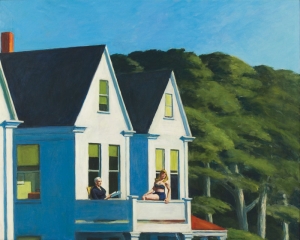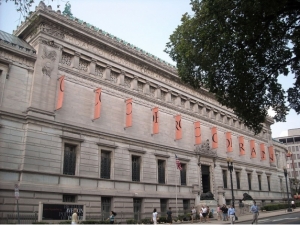|
Displaying items by tag: Edward Hopper

The Whitney Museum of American Art in New York is giving thanks to generations of benefactors with the exhibition “Shaping a Collection: Five Decades of Gifts.” Since the institution was founded in 1930, its permanent collection has grown primarily through the generosity of individual donors, beginning with sculptor Gertrude Vanderbilt Whitney’s founding gift, which included over 500 works by artists such as Thomas Hart Benton, George Bellows, Stuart Davis, Edward Hopper, Maurice Prendergast, and John Sloan. Whitney continued to add to the museum’s collection throughout her lifetime and in 1948, the institution began accepting gifts from outside sources.
Since the Whitney’s Marcel Breuer-designed building opened to the public in 1931, its permanent collection has expanded from about 2,300 objects to more than 21,000. It is estimated that nearly two-thirds of the institution’s collection, including some of its most iconic holdings, were donated by museum trustees, collectors, foundations, and artists. While “Shaping a Collection” represents a small portion of the gifts received by the Whitney, the exhibition honors all of the benefactors who have helped make the Whitney’s collection what it is today.

This summer the Frist Center for the Visual Arts presents the critically acclaimed Real/Surreal: Selections from the Whitney Museum of American Art from June 27–October 13, 2014, in the Center’s Upper-Level Galleries. Focusing on art created between the 1920s and 1950s, the exhibition traces the influence of celebrated European Surrealists on American artists ranging from Man Ray and Federico Castellón to Edward Hopper, Andrew Wyeth and many more.
Drawn from the Whitney Museum’s permanent collection, the exhibition features more than 60 paintings, photographs and prints. At the thematic heart of the exhibition is the meeting of realism—fidelity to a subject’s observable nature—and Surrealism—artwork that explores the imagination and subconscious in search of deeper realities. “This exhibition seeks to challenge and break down the traditional art historical categories of realism and Surrealism,” says Frist Center Curator Katie Delmez. “The two approaches, while seemingly opposite, do have points of convergence and their juxtaposition encourages new ways of looking at American art of this period.”
It may come as no surprise that when you ask Americans to choose their favorite artwork, Edward Hopper’s iconic “Nighthawks” sits at the top of the list. For the Art Everywhere US initiative (imported from the UK), online voters picked Hopper’s 1942 noir masterpiece and 57 other works from a curated selection of 100 pieces from the collections of five museums — the Art Institute of Chicago, the Dallas Museum of Art, LACMA, the National Gallery of Art, and the Whitney. Starting August 4, the works will adorn as many as 50,000 billboards and signs across America.
The works to go on view range from patriotic picks like Gilbert Stuart’s 1821 portrait of George Washington and Grant Wood’s “American Gothic” to more contemporary choices like photographs from Robert Mapplethorpe and Cindy Sherman. As part of a special presentation at the annual meeting of the United States Conference of Mayors, Art Everywhere will present the full list of works.
A young woman hangs sheer white linens on a clothesline. A refulgent angel descends from the heavens while shepherds tend their flocks by night. And an early motion-picture camera captures the fairyland allure of a world’s fair, slowly panning its illuminated buildings.
These vastly different images — from a 19th-century painting, a 17th-century print and a 20th-century film — are among the treasures in the current exhibition at Vassar’s Frances Lehman Loeb Art Center. What brings them together is “Mastering Light: From the Natural to the Artificial,” a quirky, thought-provoking show that divides its subject into three sometimes overlapping areas: interiors and exteriors illuminated by daylight; nighttime events made visible by moonlight or firelight; and scenes either lighted by or on the subject of artificial light.
Plenty of collectors want to donate artworks to museums, but the museums don't always welcome them with open arms. "We say 'no thanks' 19 times out of 20," says Betsy Broun, director at the American Art Museum. Sometimes the works aren't museum-quality, other times they don't fit with the museums' philosophy.
But in 1986, representatives from the Sara Roby Foundation called the Smithsonian with an offer it couldn't refuse: paintings by Edward Hopper, Raphael Soyer, Reginald Marsh and many more. They were all collected by Roby, who, in the early 1950s, took on a mission: to save Realistic art from the maws of Abstract Expressionism. The at the Smithsonian's American Art Museum.

The Portland Art Museum in Oregon has announced a monumental exhibition that will present masterpieces from the collection of Microsoft co-founder and philanthropist Paul G. Allen. “Seeing Nature: Landscape Masterworks from the Paul G. Allen Family Collection” will feature approximately 40 paintings by Claude Monet, Edouard Manet, J.M.W. Turner, Vincent van Gogh, Gustav Klimt, Edward Hopper, Georgia O’Keeffe, and others.
The exhibition, which spans five centuries of European and American landscape painting, was organized by the Portland Art Museum, the Seattle Art Museum, and the Allen Family Collection. It will debut at the Portland Art Museum in October 2015. It will then travel to The Phillips Collection in Washington, D.C., the Minneapolis Institute of Arts, and the New Orleans Museum of Art before closing at the Seattle Art Museum in early 2017.
The exhibition explores the evolution of landscape painting from the early Impressionists’ direct observations of nature to the more subjective works of the Post-Impressionists and the individualized perspectives that 20th-century artists brought to traditional landscape subjects.
Brian Ferriso, the Marilyn H. and Dr. Robert B. Pamplin Jr. Director of the Portland Art Museum, said, “Paul Allen is one of the Northwest’s most significant art collectors and philanthropists. His willingness to share his landscape masterpieces with our visitors continues his exceptional generosity and is a wonderful opportunity to be inspired by works of art that reflect his personal vision.”

The Walker Art Center in Minneapolis, Minnesota is currently hosting the exhibition “Hopper Drawing: A Painter’s Process.” Organized by the Whitney Museum of American Art in New York, the show is the first major museum exhibition to focus on the drawings and creative process of the iconic American artist Edward Hopper. Known for his enigmatic renderings of rural and urban American life, Hopper’s paintings of seascapes, cityscapes, and their inhabitants are some of the most significant artworks of the 20th century.
“Hopper Drawing” offers viewers a rare glimpse into the creative process of an artist who produced one of the most lauded oeuvres in modern art. Hopper’s drawings illustrate his ever-changing relationships with his subjects, which include the street, the movie theater, the office, his bedroom, and the road. Drawn from the Whitney’s remarkable Hopper collection, which includes 2,500 drawings given to the museum by the artist’s widow, Josephine, “Hopper Drawing” includes drafts of some of the artist’s most recognized works alongside their painted counterparts. Works on view include “Early Sunday Morning,” “New York Movie,” “Nighthawks,” and “Office at Night,” from the Walker’s collection.
“Hopper Drawing: A Painter’s Process” will be on view at the Walker Art Center through June 20, 2014.

On March 15, the Museum of Modern Art’s William S. Paley Collection will go on view at the Crystal Bridges Museum of American Art in Bentonville, Arkansas. “A Taste for Modernism” presents 62 works that cover all of the pivotal movements that defined the art world between 1880 and 1940. The exhibition features works by 24 major artists including Edgar Degas, Paul Cézanne, Paul Gauguin, Pablo Picasso, Henri Matisse, Alberto Giacometti, and Francis Bacon. The William S. Paley Collection has been on a North American tour since 2012. The Crystal Bridges Museum will be the last venue to host the exhibition before it returns to MoMA.
Highlights from the exhibition include two works by Cézanne, which Paley acquired from the artist’s son; eight works by Picasso that trace his artistic evolution over the first three decades of the 20th century, including “Boy Leading a Horse” from his Rose period, the Cubist painting “An Architect’s Table,” and the collage-inspired composition “Still Life with Guitar”; Gauguin’s “The Seed of the Areoi,” which was inspired by the artist’s trips to Tahiti; and realist landscapes by Edward Hopper.
William S. Paley, the media mogul who built the CBS broadcasting empire, was an important art collector and philanthropist. Paley began collecting in the 1930s and had a particular fondness for French modernist movements such as Fauvism, Cubism, and Post-Impressionism. Paley played a major role in establishing MoMA as one of the most significant institutions in the world and he fulfilled various roles at the museum including patron, trustee, president, and board chairman from 1937 until his death in 1999.
“A Taste for Modernism” will remain on view at the Crystal Bridges Museum of American Art through July 7.

Between 2010 and 2013, 100 American masterworks from the Phillips Collection in Washington, D.C. traveled to museums in Italy, Spain, Japan, Tennessee, Texas, and Florida. The exhibition earned rave reviews and was seen by more than 30,000 people. The Phillips Collection is currently hosting an expanded version of this hit show, titled “Made in the USA: American Masters from the Phillips Collection, 1850-1970.”
The exhibition is the most comprehensive presentation of the museum’s American art collection undertaken in nearly 40 years. “Made in the USA” presents over 200 works from the museum’s holdings including seascapes, city scenes, abstract canvases, and portraits. The exhibition is organized chronologically, beginning with American art from the late 19th century and ending with works from the postwar years. “Made in the USA” includes paintings, drawings, and etchings by Thomas Eakins, Rockwell Kent, Edward Hopper, John Marin, Arthur Dove, and Willem de Kooning.
The Phillips Collection, which was founded in 1921 by Duncan Phillips, was the first museum in the United States dedicated to American art. Over the course of 50 years, Phillips built a collection of nearly 2,000 pieces of modern art of which 1,400 were American.
“Made in the USA” will be on view at the Phillips Collection through August 31.

According to a plan announced on Wednesday, February 19, Washington, D.C.’s Corcoran Gallery of Art could hand over its vast, 17,000-piece collection to the government-backed National Gallery of Art. Under the proposed plan, George Washington University would assume control of the Corcoran’s historic Beaux-Arts building as well as the Corcoran College of Art and Design.
The proposal aims to keep the Corcoran open to the public and its collection, which features works by Claude Monet, Pablo Picasso, Winslow Homer, John Singer Sargent, Edward Hopper and Willem de Kooning, would remain in public institutions. The National Gallery would present exhibitions of modern and contemporary art in the Corcoran under the name Corcoran Contemporary, National Gallery of Art. It would also oversee the Corcoran Legacy Gallery, which would present a selection of works from the Corcoran’s collection.
The Corcoran, the largest privately supported art museum in the country, opened to the public in 1897. The museum has been struggling financially for years and is in need of considerable renovations.
A decision regarding the proposal is expected to be made in April.
|
|
|
|
|